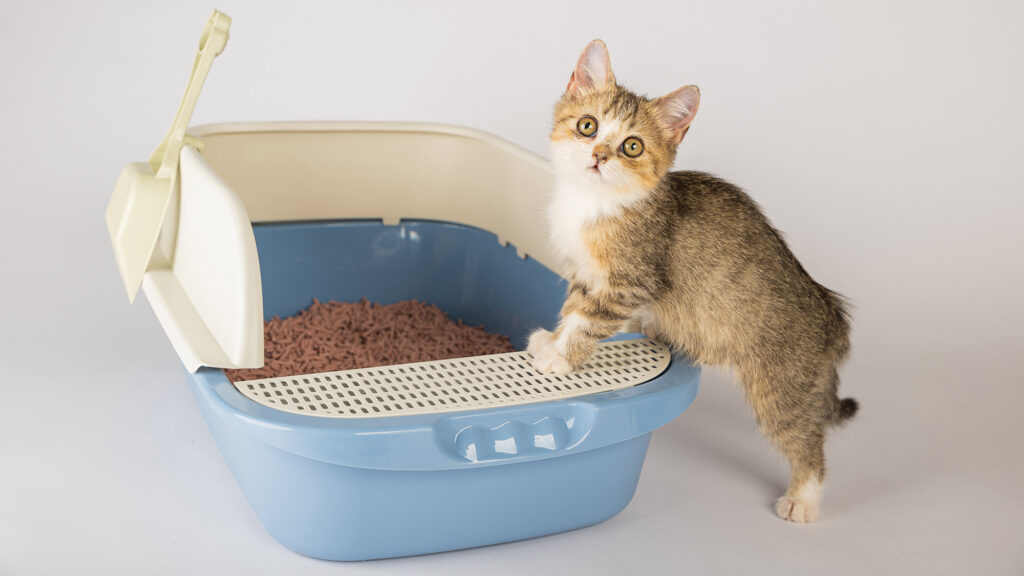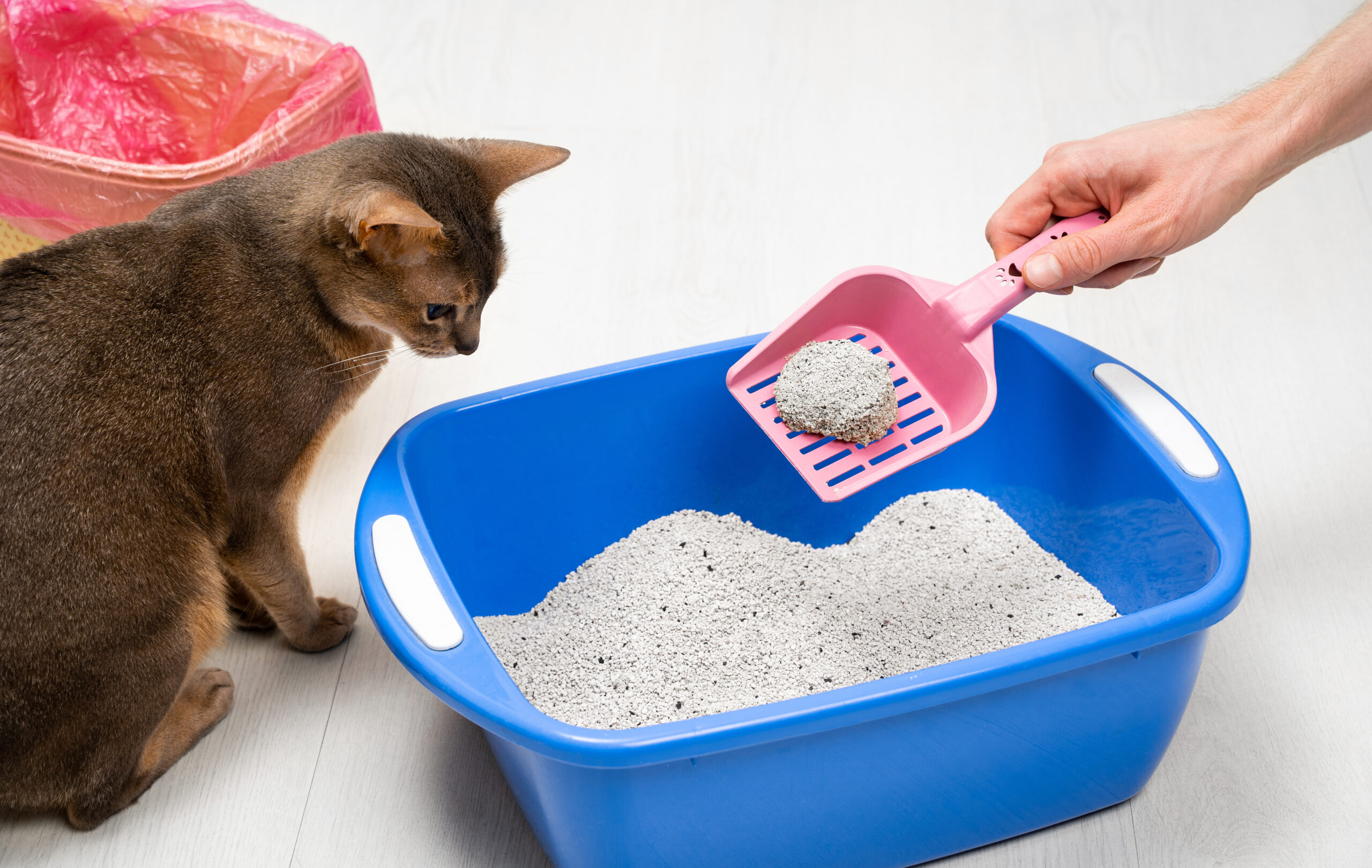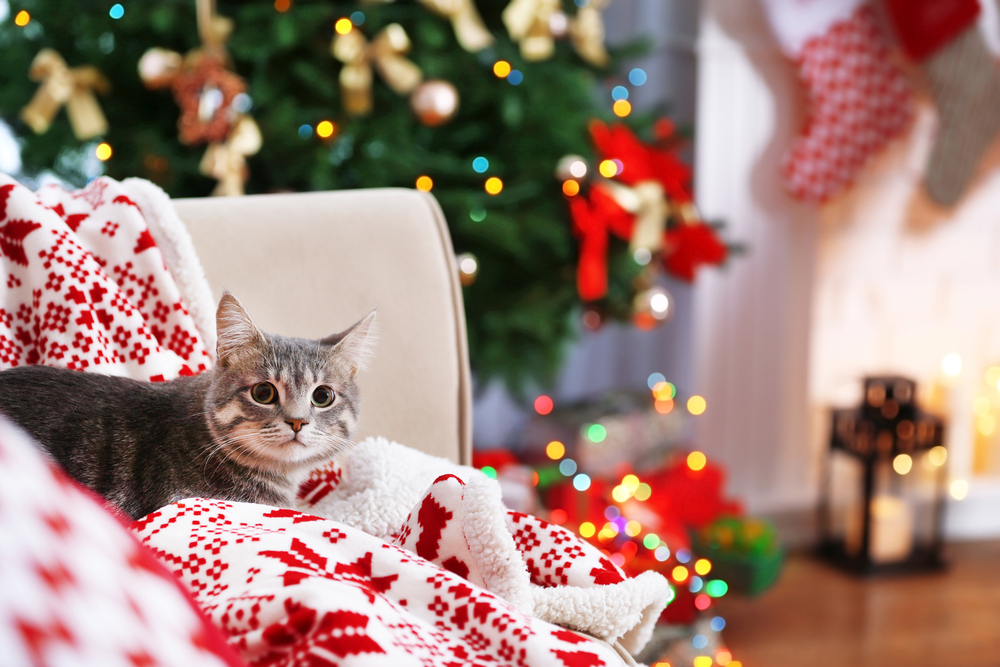Written by Jessica Mockett, Purrrfect Bonds Feline Behavior & Training and Holistic Pet Health Coaching
With countless litter boxes and substrates flooding the market, what’s a cat guardian to do to get it right? We often make selections based on our own preferences, unintentionally leaving our cats’ needs out of the equation. We might choose a small, lidded box filled with pine pellets and place it in the laundry room next to the appliances. From a human perspective, these choices seem logical: the small box saves space, the lid conceals messes and reduces odors, the pellets smell pleasant and cost less, and the laundry room keeps everything out of sight while providing easy-to-clean hard floors.
But consider your cat’s perspective: Once fully grown, that small box becomes difficult to navigate—there’s barely enough space to turn around or dig, so sometimes his rear end hangs out the entrance, creating accidental messes. His sense of smell, which is 14-20 times more acute than ours, makes the enclosed box overwhelming as odors become trapped and the plastic absorbs urine over time despite regular cleaning. The pine pellets add another unpleasant odor while being lumpy and difficult to dig through. As he ages and develops arthritis, those large pellets become painful on his paws. In the laundry room, sudden sounds from the water heater or dryer buzzer can cause panic during vulnerable potty moments.
This represents just one common scenario among hundreds where what we consider “good enough” actually frustrates, hurts, or frightens our cats. While cats may tolerate subpar conditions temporarily, they may reach a “final straw” moment with the arrangement. To develop greater understanding we must examine the situation through our cats’ eyes—not by anthropomorphizing (projecting our thoughts and feelings onto them), but by genuinely considering their physical and sensory experience.

I recently counseled a client whose cat avoided the litter box for defecation, often choosing elevated surfaces and usually timing his activities when the dogs were walked. I suggested the cat might feel uncomfortable with the dogs’ presence during such exposed moments. She asserted that her cat liked the dogs, so that couldn’t be the issue. I asked, “Even though you love your husband, would you want him standing in front of you and staring while you poop?” She laughed and conceded she would not appreciate that.
No perfect or magical combination of box style, quantity, location, substrate, and cleanliness level works for every cat. However, commonalities among feline preferences point to general guidelines. Let’s explore these standards, and if you’re experiencing litter box issues, consider making changes that address your cat’s bathroom needs.
Step One: Number of Boxes
The number of boxes you need depends on three criteria: how many cats live in your home, how many levels your home has, and your home’s square footage. The general rule requires one box per cat plus one additional box, at least one box on each level accessible to cats, and at least one box for every 750 square feet of space.
Examples:
- One cat, three stories, 1,800 square feet = at least three litter boxes (one per level)
- Four cats, 4,400 square foot ranch = five to six total boxes
- One cat, two stories, 3,000 square feet = three to four boxes
Step Two: Locations
This challenge stumps many cat owners. When we find one good spot, we tend to cluster all required boxes there. I’ve made this mistake myself. Unfortunately, many cats perceive three boxes lined up as a single bathroom, which can create territorial stress in multi-cat households.
When selecting box locations, avoid areas with large appliances or electronic devices that produce scary or unexpected noises. While some cats tolerate appliances, others don’t—if you have litter box issues with a box situated near the furnace, consider relocating it elsewhere on that floor.
Avoid overly hidden locations that become inconvenient for cats to access. Crawl spaces, attics, and garages might appeal to us but feel unpleasant to cats, so don’t be surprised when they reject these spots. Sometimes we must place boxes in areas we’d prefer to avoid, like living rooms or bedrooms.
Step Three: Litter Substrates
Much commercial litter targets human preferences, especially heavily scented or artificially colored varieties. When selecting substrate, respect your cat’s preferences. Since domestic cats descend from desert cats, most prefer sand-like substances. Cats accustomed to specific substrates from kittenhood may retain that preference lifelong. However, we must remain open to our cats changing their preferences and be willing to accommodate appeals for more comfortable options.
When choosing litter, prioritize the right option over the cheapest. Avoid scented litters and artificial dyes—the more natural, the better. Softer textures suit most cats best. Clumping litters keep the boxes cleaner overall for longer. Consider brands like Fresh Step Unscented, Sustainably Yours, World’s Best, or Swheat Scoop. Cats struggling with litter box use might benefit from Cat Attract litter or children’s sandbox sand. Cats with paw pain from declawing or severe arthritis may need puppy pads instead of textured materials.
Remember that some cats prefer digging for both urination and defecation, others only for one or the other. A few cats need separate boxes and substrates—one for urine, one for feces.

Step Four: Box Shapes, Sizes, and Styles
Like litter options, box choices abound. I find commercial litter boxes overpriced and usually too small. Box size should be one and a half times your cat’s body length and at least as wide. As a standardization, boxes should measure 24 inches long and 18 inches wide. I frequently recommend large 36 inch long storage bins from retailers like Walmart or Target as cost-effective alternatives.
Consider your cats’ specific needs:
- Kittens need easily accessible boxes when small but then increased box size as they grow
- Senior cats may require zero-entry, walk-in boxes
- High pee-ers or cats with “elevator butt” need tall-sided boxes
- Odor-sensitive cats may reject lidded boxes or furniture-concealed units
Many cats, especially those introduced to them as adults, dislike automated litter boxes. Don’t get frustrated if your cat uses the auto-box for one waste function but not the other, or refuses it entirely. From the cat’s perspective, these devices pose risks through the seemingly random sounds and movements. Cats always have valid reasons for their bathroom preferences.
Step Five: Cleanliness
Cats are fastidious groomers who appreciate clean potty facilities. Too many of us fall short of meeting their cleanliness standards. Struggling cats may need more vigilant scooping schedules. Once daily represents the standard for every box, though finicky cats may require scooping two to three times daily.
Full box cleaning frequency depends largely on substrate choice. Some litters excel at odor control, allowing weekly additions before complete refreshing every four to six weeks. Other litters require daily or weekly dumping and box cleaning before refilling. Gauge your cat’s cleanliness preferences and increase full cleaning frequency as needed. Use unscented soaps and hot water to clean.
Final Thoughts
Not all cats are alike! You may have several in your home with different preferences or special needs requiring accommodation. If your cat appears content with his litter arrangements and you are not currently meeting all of these standards, you do not need to make immediate changes. However, be open to future adjustments and when replacing equipment, upgrade to larger boxes and slowly shift to better substrates.
If this article inspires a desire to implement changes, transition slowly. Gradually blend new substrates with old ones. When relocating boxes, move them a few feet at a time to the new spot, or place a new box in the desired location while leaving the old one temporarily, allowing adjustment time before removing the original.
Many litter box nuances beyond this article’s scope may apply to your situation. Consider hiring a feline behavior consultant like myself if you’re experiencing litter box accidents—the sooner, the better. It’s disheartening when clients seek help after years of problems, as long-term cases prove much harder to resolve than fresh concerns.
Always remember that health issues could factor into litter box struggles. I strongly recommend veterinary evaluation including complete physicals, bloodwork, urinalysis, and fecal examinations.
























































































